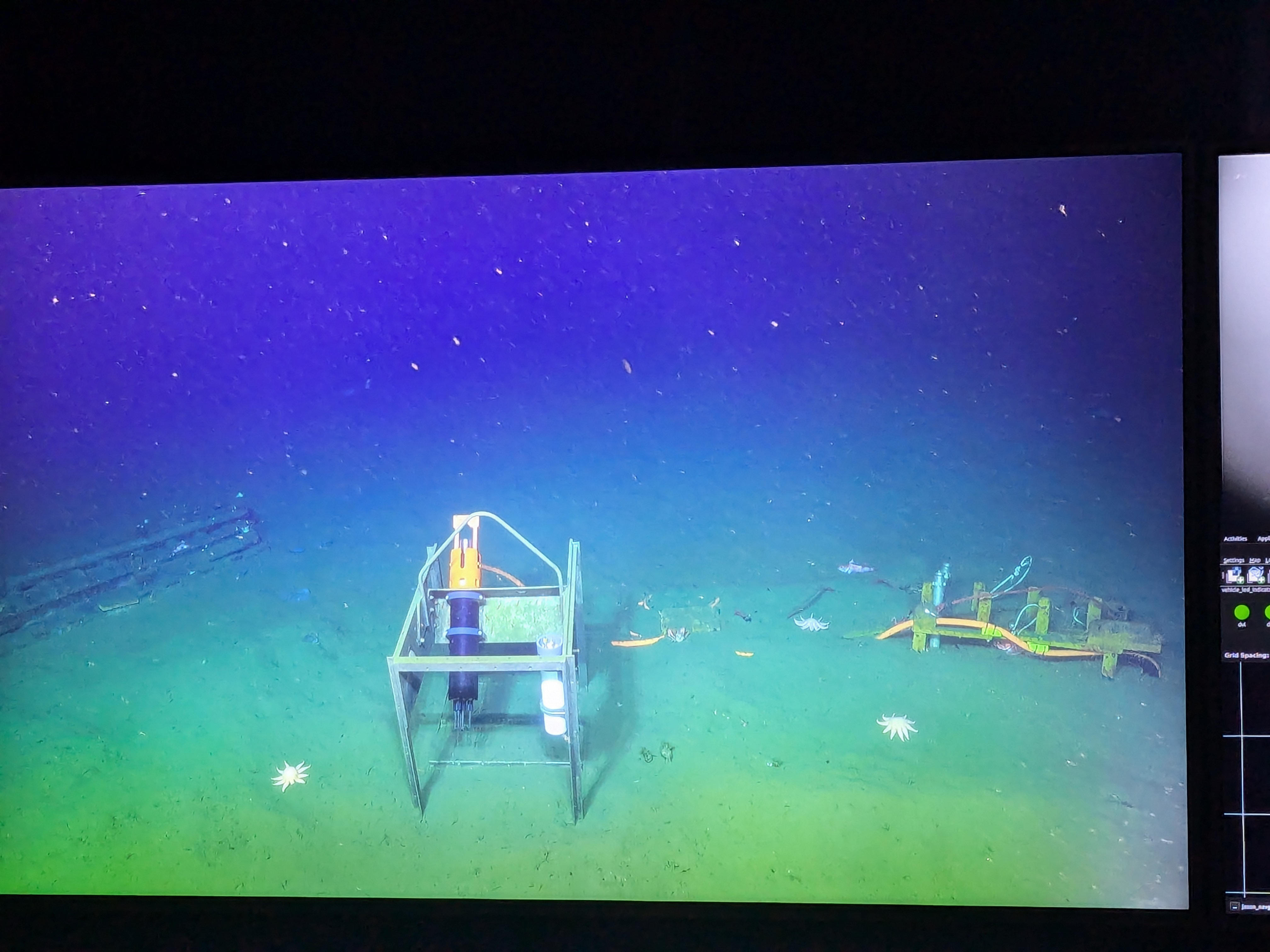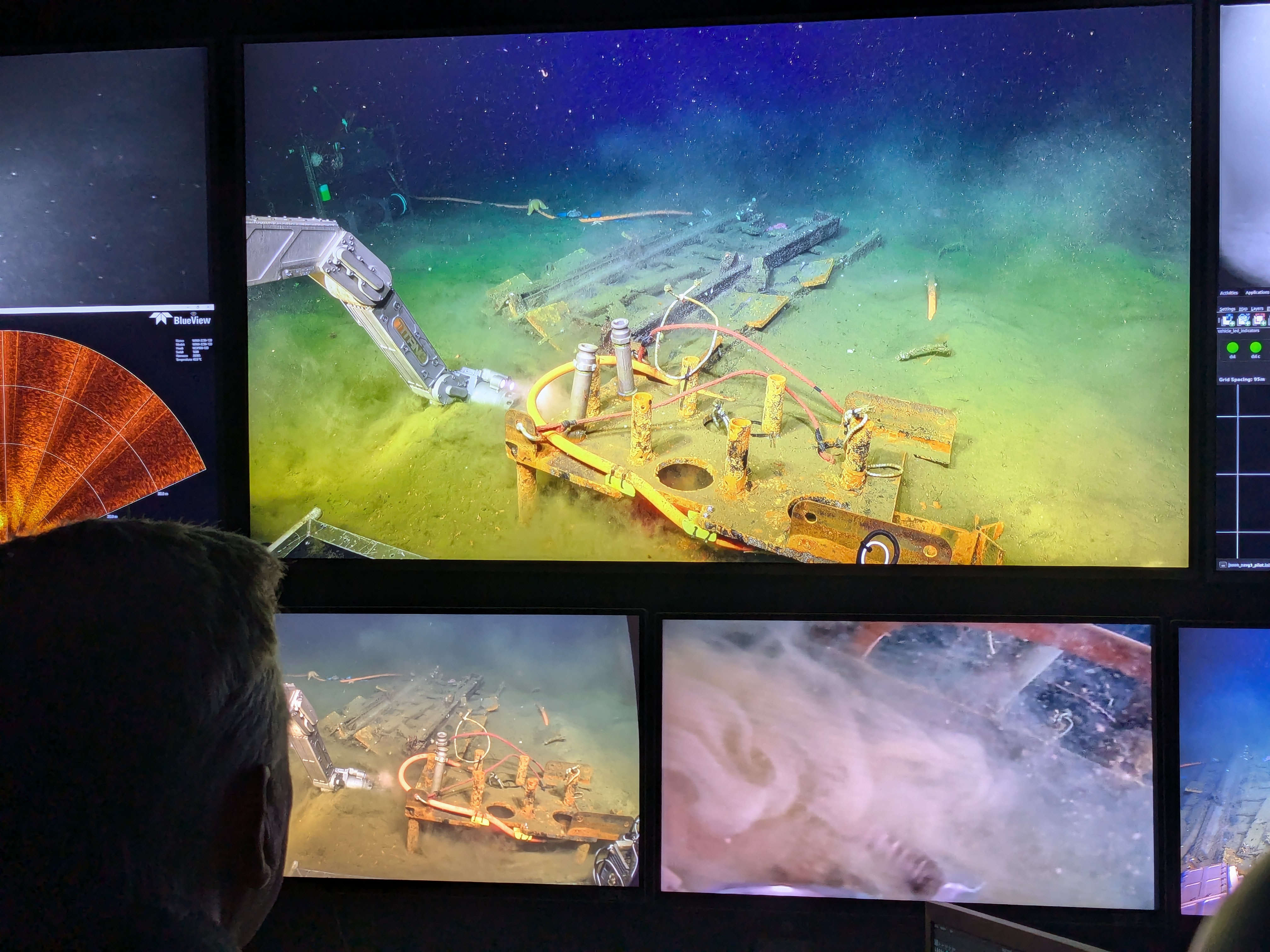All Aboard! Conducting research at sea
The other goal for this mission was to retrieve data from a strainmeter and check its functionality. The strainmeter experiment is part of the overall family of instruments that are deployed along the Cascadia Subduction Zone (CSZ) to measure different seismic behavior along the subduction trench. So off we went to our location and that’s where we hit our first snafu.
A strainmeter is a sensitive instrument that measures strain or the amount of deformation experienced over a certain period of time. The workings of a strainmeter is pretty simple: measure the change in distance between two points using a solid piece of material or a laser beam. In our case, we used an optical fiber cable and a laser beam to calculate the deformation experienced at Cascadia. The fibers are shallowly buried within the sediments with its ends anchored by metal pipes that are buried deeply in the ocean bed. The instrument measures the two way travel time as the laser light travels through the cable and back. As the fiber gets stretched and changes its length, the light within the optical fiber changes its phase. We can measure the change in length of the fiber relative to a reference fiber to detect very precise motions of the tectonic plates and the deformation that the plates have accumulated. How precise: It gives us a measurement that is precise to less than the width of human hair! In this experiment, we placed two of these strainmeters at right angles to each other to measure both the N-S and E-W strain at the subduction zone.
 Our co-PI. Dr Noel Jackson, walking us through the workings of the Seafloor Optical Fibre Strainmeter (SOFS).
Our co-PI. Dr Noel Jackson, walking us through the workings of the Seafloor Optical Fibre Strainmeter (SOFS).
Servicing a strainmeter means replacing its recoverable electronics module (REM, aka REMy). REMy is a metal frame that contains a battery pack, a data recorder and a computer that is connected to the strainmeter setup. The strainmeters are not connected to the outside world, so it requires regular check ups wherein we have to bring that REMy up, take the data recorder out, replace the batteries and then take it back down to the strainmeter. This is where our good friend, ROV Jason comes in.
Jason goes to the strainmeter and does a tug test on the optical fibers to make sure they are in tension. Jason’s cameras also allowed us to see some deep sea friends, like huge crabs, anemones, and a fish that decided to burrow under the strainmeter plate and call it its home. Both our strainmeters passed the test. Next, Jason has to bring the old REMy up on board the ship where we can check the data it has collected over the past one year. Our recovery of old REMy was successful. Jason went down to the seafloor, shoo-ed away some enormous crabs that had made REMy their home, grabbed REMy by the frame and up it came on board as we saw it in our mission control room.
 The old Replaceable Electronic Module (REM-y) with some of its deep sea neighbors. Spot the ten-legged starfish and a hidden orange fish.
The old Replaceable Electronic Module (REM-y) with some of its deep sea neighbors. Spot the ten-legged starfish and a hidden orange fish.
However, new REMy gave us an issue. New REMy did not like the high pressure, seawater environment. The electronics on the new REMy had false connections to our onboard computer due to an electric short in seawater. This meant that we could not leave the new REMy on the seafloor for its next year of operations since it wasn’t responding to our tests properly. After a lot of emergency meetings of the science party, Jason was instructed to bring up the new REMy on board so that we can look at it more closely and fix the problem within the time frame of the mission. Luckily, when at sea, we plan for contingencies. After a quick meeting with the captain of the ship, Jason expedition leader and science party PIs, we decided that we will come back to this location on our last day of the expedition once we have completed the GNSS-A mission goals.
 ROV Jason preparing for a tug test on one of the ends of the strainmeter. We had a lot of sediments and hidden sea critters around the strainmeter!
ROV Jason preparing for a tug test on one of the ends of the strainmeter. We had a lot of sediments and hidden sea critters around the strainmeter!
On our last day, we went back to the strainmeters. After a lot of discussions and prioritizing what is absolutely required for the working of the instrument, we created a Franken-REMy (a frankenstein version of REMy) which had the battery, the data recorder but not the optical connecting modem. We did some final tests to make sure that all the components of Franken-REMy were working and the computer on it was going to record data for the next year. Jason did a final tap on the strainmeter, said goodbye to the crabs before it came back up on the deck having successfully completed its tasks for this expedition!
Our experience with the strainmeter was full of highs and lows. Dealing with very precise electronic instruments at the bottom of the sea floor with saline water and high water pressure is a challenge even in the best of times. With all the uncertainties involved with ocean currents, weather conditions, it makes us prepared for any contingencies to pivot at the very last second while giving it our very best to meet the requirements of the mission. It requires a massive amount of coordination across multiple teams to make the mission a success. But at the end of the day, you get to do cool science experiments at sea while looking at some gorgeous sunrises and sunsets. Feels pretty good, I would say!
 Jason had to shoo away one of the residents of old REMy, aka, Mr Crab. This was one of three massive crabs that made REMy their home. Mr Crab was the feisty one who protested the eviction.
Jason had to shoo away one of the residents of old REMy, aka, Mr Crab. This was one of three massive crabs that made REMy their home. Mr Crab was the feisty one who protested the eviction.